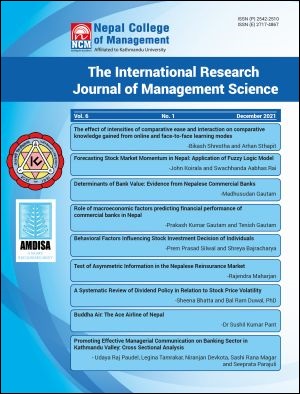Promoting Effective Managerial Communication on Banking Sector in Kathmandu Valley: Cross Sectional Analysis
DOI:
https://doi.org/10.3126/irjms.v6i1.42352Keywords:
Banking Communication , Commercial Banks, Managerial Communication Index, Descriptive Analysis, KathmanduAbstract
Purpose: Efficient managerial level is crucial to any organization for well function and betterment of the organization. Likewise, managerial communication is essential to build good relationship among managers to their subordinates. Proper communication in banks further helps to assist employees, creating sense of mutual respect and favorable working environment. This study aims to identify strategy for promoting effective managerial communication in banking sector in Kathmandu valley.
Research Design/ Methodology: A descriptive cross-sectional research design has been applied for this study where 405 managers (383 branch managers and 22 operating managers) of commercial Banks in Kathmandu Valley were taken as a sample using structured questionnaire survey using KOBO Toolbox. This study develops and uses Managerial communication index to identify the communication skills of managers in banking communication and decision making.
Findings: Managerial Communication Index value shows that managers of banking sector in Kathmandu valley are highly aware of managerial communication in terms of identity factors, negotiation and adaptation, and decision making. Brining clarity while giving speech or talking (69.13%), regularly gathering feedback for improvement (16.54%) and changing behavior and perception when necessary (12.34%) are some of the management strategies identified for promoting effective managerial communication.
Conclusion: Hence, the study concludes that bank managers must properly disseminate the information to its stakeholders which will help to convey message effectively leading clarity in the work and enhancing productivity.
Recommendations: The paper recommends that there should be inclusive climate in the workplace. Further, policies supporting communication should be forwarded.
Originality: This article is original and there is no potential conflict of interest with respect to research and publication of this article.




